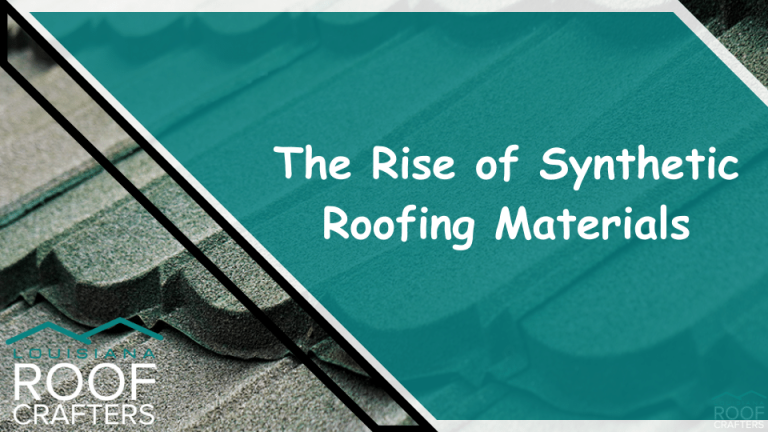The Rise of Synthetic Roofing Materials with Louisiana Roof Crafters. Roofing materials have come a long way over the years, evolving from traditional options like wood, clay, and asphalt to a wide array of synthetic materials. The rise of synthetic roofing materials has been a game-changer in the roofing industry, offering homeowners numerous benefits in terms of durability, cost-effectiveness, and environmental sustainability. In this article, we’ll explore the growing popularity of synthetic roofing materials, their advantages, and the various options available to homeowners.

The Advantages of Synthetic Roofing Materials:
Durability: One of the most significant advantages of synthetic roofing materials is their exceptional durability. Many synthetic materials are engineered to withstand harsh weather conditions, including heavy rain, strong winds, and even hail. They are also resistant to rot, mold, and insect infestations, which can extend their lifespan.
Cost-Effective: While some synthetic roofing materials may have a higher upfront cost compared to traditional options, their long-term cost-effectiveness is often superior. Synthetic roofs typically require less maintenance and repair, translating to reduced overall expenses over the life of the roof.
Variety of Styles: Synthetic roofing materials come in various styles, colors, and textures, allowing homeowners to achieve the aesthetic they desire. Some synthetic materials can even mimic the appearance of traditional roofing materials like slate, wood shakes, or clay tiles.
Lightweight: Many synthetic roofing materials are lightweight, which can reduce the strain on the roofing structure and minimize the need for additional support. This can be particularly beneficial for older homes or structures with weight limitations.
Energy Efficiency: Some synthetic roofing materials are designed with energy efficiency in mind. They may have reflective properties that help reduce heat absorption, thereby lowering cooling costs in hot climates.
Environmental Sustainability: Synthetic roofing materials are often made from recycled or recyclable materials, making them an eco-friendly choice. Additionally, their long lifespan means less waste in landfills from roofing material disposal.
Easy Installation: Synthetic roofing materials are typically easier and quicker to install compared to traditional options. This can lead to cost savings in terms of labor and installation time.
Types of Synthetic Roofing Materials:
Synthetic Slate: Synthetic slate roofing materials are made from composite materials like rubber, plastic, or a combination of both. They mimic the appearance of natural slate but are significantly lighter and more affordable. They are also easier to install and maintain.
Synthetic Wood Shakes: These materials replicate the look of traditional wood shakes but offer better resistance to rot, fire, and insect damage. They are typically made from polymer-based materials and can be more durable and longer-lasting than real wood.
Synthetic Clay Tiles: Synthetic clay tiles are often composed of a combination of clay and polymers. They imitate the aesthetics of traditional clay tiles while being lighter and more cost-effective. They are also available in various colors and profiles.
Synthetic Asphalt Shingles: Synthetic asphalt shingles are designed to resemble traditional asphalt shingles but are typically more durable and weather-resistant. They often incorporate advanced technologies that enhance their performance.
Synthetic Metal Roofing: Some metal roofing materials are coated with synthetic materials to improve their aesthetics and reduce noise during rain or hailstorms. These synthetic-coated metal roofs offer the durability of metal with added benefits.
Maintenance Tips for Synthetic Roofing Materials:
Regular Inspections: Schedule annual roof inspections to identify any damage or issues that may require attention. Address any repairs promptly to prevent further damage.
Cleaning: Clean your synthetic roof periodically to remove debris, dirt, and moss or algae growth. Use mild detergents and a soft brush to avoid damaging the roofing material.
Gutter Maintenance: Keep gutters and downspouts clear to ensure proper drainage and prevent water backup under the roofing material.
Trim Overhanging Branches: Regularly trim branches that hang over your roof to prevent potential damage from falling limbs during storms.
Proper Ventilation: Ensure your attic has proper ventilation to prevent heat and moisture buildup, which can affect the longevity of the roofing material and underlayment.
Snow Removal: In areas prone to heavy snowfall, consider safely removing excess snow from your roof to prevent overloading.
In Conclusion:
The rise of synthetic roofing materials has revolutionized the roofing industry, offering homeowners a wide range of benefits, including durability, cost-effectiveness, and sustainability. With various styles and options to choose from, homeowners can find synthetic roofing materials that meet their aesthetic preferences while also providing superior performance and longevity. If you’re considering a roof replacement or installation, consult with a reputable roofing professional to explore the synthetic roofing material options best suited to your home and climate.
Call Louisiana Roof Crafters at 225-238-6396 for more information. We service areas in Baton Rouge, Denham Springs, Hammond, Covington, Mandeville, Slidell, and New Orleans, LA.




